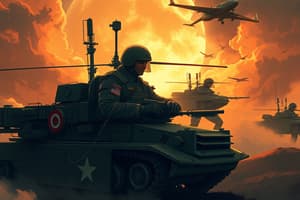Podcast
Questions and Answers
What does ADP 7-0 cover?
What does ADP 7-0 cover?
Training units and developing leaders
What are the three training domains the Army uses?
What are the three training domains the Army uses?
- Self-development (correct)
- Strategic
- Institutional (correct)
- Operational (correct)
What is the institutional training domain?
What is the institutional training domain?
Training base centers and schools that provide initial training and subsequent professional military education for soldiers, military leaders, and army civilians
What is the operational training domain?
What is the operational training domain?
What is the self-development training domain?
What is the self-development training domain?
What is unified action?
What is unified action?
Who is responsible for training units and developing leaders?
Who is responsible for training units and developing leaders?
How do commanders exercise training and leadership development?
How do commanders exercise training and leadership development?
What is individual training?
What is individual training?
What is collective training?
What is collective training?
What are the 11 principles of unit training?
What are the 11 principles of unit training?
Who is responsible for the training proficiency of their respective organizations and subordinates?
Who is responsible for the training proficiency of their respective organizations and subordinates?
Who are the primary trainers of enlisted Soldiers?
Who are the primary trainers of enlisted Soldiers?
What do leaders need to establish and enforce to ensure their organizations meet mission requirements?
What do leaders need to establish and enforce to ensure their organizations meet mission requirements?
What fundamentals must units at every echelon master in order to accomplish their missions?
What fundamentals must units at every echelon master in order to accomplish their missions?
What leaders attribute results from training under complex, changing conditions with minimal information available to make decisions?
What leaders attribute results from training under complex, changing conditions with minimal information available to make decisions?
What training technique allows for simultaneous training of more than one echelon on different or complementary tasks?
What training technique allows for simultaneous training of more than one echelon on different or complementary tasks?
Which training principle prepares units and individuals to be resilient?
Which training principle prepares units and individuals to be resilient?
What are the seven principles of leader development?
What are the seven principles of leader development?
What should all leaders know about their subordinates?
What should all leaders know about their subordinates?
What is the primary focus of a unit when not deployed?
What is the primary focus of a unit when not deployed?
What is the purpose of unit training?
What is the purpose of unit training?
What do units build once they master individual and collective tasks under the conditions of their anticipated operational environment?
What do units build once they master individual and collective tasks under the conditions of their anticipated operational environment?
What is the definition of METL?
What is the definition of METL?
What does METL stand for?
What does METL stand for?
What is the goal of METL proficiency?
What is the goal of METL proficiency?
What type of approach do unit training plans use that progressively and systematically build on successful task performance before progressing to more complex tasks?
What type of approach do unit training plans use that progressively and systematically build on successful task performance before progressing to more complex tasks?
What do subordinates provide in order to enable the commander to assess the readiness of a mission essential task?
What do subordinates provide in order to enable the commander to assess the readiness of a mission essential task?
Through training, units, leaders, and Soldiers achieve what?
Through training, units, leaders, and Soldiers achieve what?
Define Leader Development.
Define Leader Development.
Why do commanders exercise mission command?
Why do commanders exercise mission command?
Who can assess METL readiness?
Who can assess METL readiness?
Flashcards are hidden until you start studying
Study Notes
Overview of ADP 7-0
- Focuses on training units and developing leaders in the Army.
- Emphasizes the importance of synchronization, coordination, and integration, termed unified action.
Army Training Domains
- Institutional Training: Involves training base centers and schools for soldiers, leaders, and Army civilians.
- Operational Training: Conducted by organizations at home stations and during exercises, mobilizations, or deployments.
- Self-Development Training: Goal-oriented learning that promotes personal growth, situational awareness, and professional competence.
Responsibilities in Training
- Commanders are crucial for both training and leadership development.
- Subordinate leaders ensure training proficiency in their respective units.
- Noncommissioned Officers (NCOs) are primary trainers for enlisted Soldiers.
Training Approaches and Principles
- Individual training emphasizes personal responsibility for growth.
- Collective training synchronizes skills learned individually.
- Training principles include adaptability, standards setting, fundamental mastery, and multi-echelon training.
- The "crawl, walk, run" approach helps build progressively complex skills.
Mission Essential Task List (METL)
- Defines the core tasks for which units are designed.
- Proficiency in METL enables units to handle unexpected situations during missions.
- The commander is responsible for assessing METL readiness through After Action Reviews (AARs).
Leader Development
- Continuous and progressive throughout a leader's career.
- Key principles include leading by example, fostering a learning environment, and knowing subordinates' strengths and weaknesses.
Focus and Purpose of Unit Training
- Non-deployed units prioritize training to build readiness for unified land operations.
- Mastery of tasks contributes to aspects like flexibility, lethality, adaptability, and synchronization capabilities.
Training Techniques and Resilience
- Multi-echelon training allows units to train simultaneously on different tasks.
- Training to sustain is a principle aimed at preparing units to remain resilient.
Importance of Adaptability
- Leaders embody adaptability through training in complex environments, aiding decision-making with limited information.
- Achieving tactical and technical competence through training builds overall confidence and adaptability in units, leaders, and Soldiers.
Studying That Suits You
Use AI to generate personalized quizzes and flashcards to suit your learning preferences.




